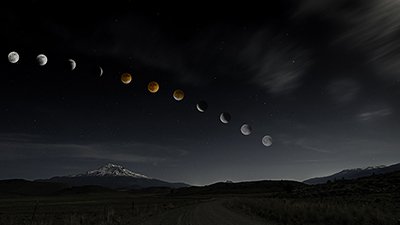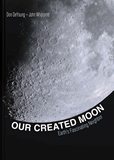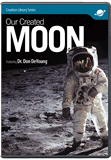Our Scarred Moon
Moon story stretches to accommodate unexpectedly recent activity.
News Source
- Space.com: “Moon’s Scarred Crust Hints at Recent Activity, Scientists Say”
- Space-travel.com: “NASA Spacecraft Reveals Recent Geological Activity on the Moon”
Surprising evidence of recent tectonic activity on the moon may prompt a re-evaluation of scientific ideas about the moon’s origins and geologic history. Images collected by the Lunar Reconnaissance Orbiter (LRO) reveal grabens—linear valleys formed “when the moon’s crust stretches, breaks, and drops down” between the faults. Evidence of recent stretching is unexpected enough, since other evidence has shown the moon to be contracting. But these grabens give evidence of their recent origin in that they are “pristine,” relatively unmarred by craters suggestive of meteor impact over time.
“We think they're less than 50 million years old, but they could be 10 million years old, could be 1 million years old, could have happened 40 years ago,” says Thomas Watters, lead author of the report just published in Nature Geoscience. Seismic sensors placed by the Apollo missions have also detected moonquakes. “The intriguing picture that's emerging of the moon is that there is recent geological activity going on. The moon may not only have been tectonically active recently, but may still be tectonically active today.”
LRO images from August 2010 were consistent with predominant current secular opinion suggesting the moon’s crust is contracting. “We think the moon is in a general state of global contraction because of cooling of a still hot interior,” says Watters. “The graben tell us forces acting to shrink the moon were overcome in places by forces acting to pull it apart. This means the contractional forces shrinking the moon cannot be large, or the small graben might never form.”
Meteor impacts cause craters. Micrometeoroids may scour and erode previously formed geological features on the airless moon. The more cratered the moon’s surface, or the more its craters have been eroded, the older the features are likely to be. Therefore, these pristine grabens are thought to be relatively young. But how young is a mystery even for secular scientists.
“We can determine relative dates of lunar features by using principles of stratigraphy and morphology,” explains creationist astronomer Dr. Danny Faulkner of the University of South Carolina–Lancaster. “Stratigraphy refers to overlap of geological features —if one feature, say a crater, lies on top of another feature, then we say that the feature on top has modified the feature underneath, and clearly the feature on top happened more recently and hence is younger. Morphology relates to the shapes of lunar features. On the earth, erosion (mostly from water, wind, and vegetation) rapidly alters and wears down geological features. Lacking an atmosphere, erosion on the moon appears much slower, but there are erosion processes on the moon. The most important erosion process on the moon is impacts, be they from large bodies or from very small bodies called micrometeoroids. Micrometeoroids make microscopic craters, but they are very numerous, so they tend to wear down sharp edges on lunar features. Generally, if one lunar feature appears very sharp but another appears more worn, the more worn feature is judged older. Using these principles of stratigraphy and morphology, the density of craters in a region on the moon can be used to determine the region’s relative age. If a region has a high crater density, presumably that region has been subjected to more impacts, most likely because of greater time since that region formed. That is, the greater the crater density, the greater the relative age. We use this principle to establish lunar highlands are older than lunar maria.”
But determining absolute ages of the moon’s features depends on assumptions about the age of the universe. Dr. Faulkner explains, “Recent creationists and evolutionists agree on these principles to establish relative ages. Where we disagree is how to convert those relative ages to absolute ages, for other assumptions or information must be brought in to do that. Evolutionists are committed to billions of years, so they stretch impact events over that great time, and they interpret lunar history accordingly. On the other hand, recent creationists believe the world is only thousands of years old, so we understand lunar craters formed in a relatively short time, and we interpret lunar history in light of that. As in so many other cases, we use the same data, but we come to different conclusions, because our assumptions are different.”
Secular cosmologists have changed their thoughts about the moon’s origins over the years, but they consistently develop models based on the underlying assumption that the universe is billions of years old. Yet their long-age model is based on a number of unverifiable and untestable assumptions and has scientific problems of its own.
Biblical creationists understand the Bible contains God’s eyewitness account of His creation of the universe about 6,000 years ago. He made the sun, moon, and stars on the Fourth Day of Creation Week. Craters on the moon—and the moon itself—must be no more than 6,000 years old.
Further Reading
- A Biblically-Based Cratering Theory
- Response to Faulkner’s ‘Biblically-Based Cratering Theory’
- The Age of the Universe, Part 1
- The Age of the Universe, Part 2
- Astrophysics and the age of the universe
- Does the Big Bang Fit with the Bible?
- Our Created Moon
For More Information: Get Answers
Remember, if you see a news story that might merit some attention, let us know about it! (Note: if the story originates from the Associated Press, FOX News, MSNBC, the New York Times, or another major national media outlet, we will most likely have already heard about it.) And thanks to all of our readers who have submitted great news tips to us. If you didn’t catch all the latest News to Know, why not take a look to see what you’ve missed?
(Please note that links will take you directly to the source. Answers in Genesis is not responsible for content on the websites to which we refer. For more information, please see our Privacy Policy.)
Recommended Resources

Answers in Genesis is an apologetics ministry, dedicated to helping Christians defend their faith and proclaim the good news of Jesus Christ.
- Customer Service 800.778.3390
- © 2024 Answers in Genesis








